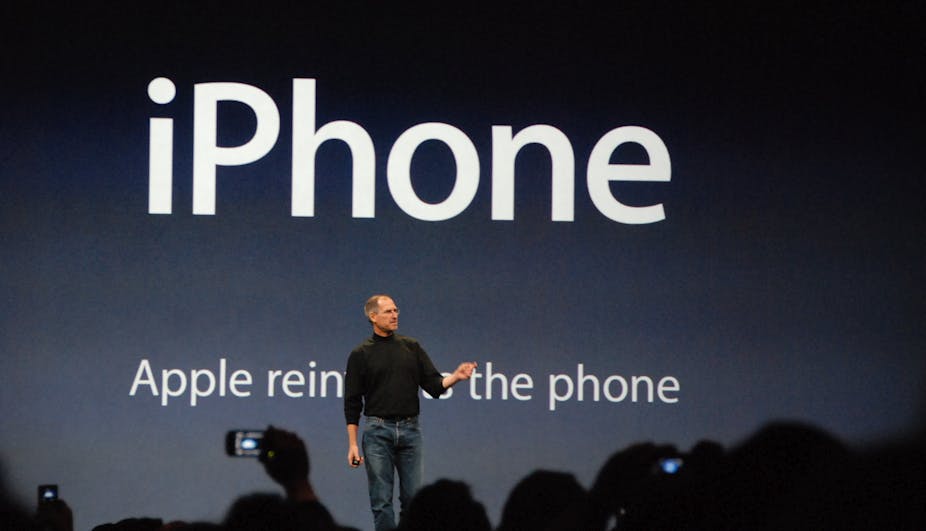The 10th anniversary of the Apple iPhone reminds us that while it was not the first smartphone, it was the first to achieve mass-market appeal. Since then the iPhone has defined the approach that other smartphone manufacturers have taken.
Smartphones have transformed our lives, essentially giving us an internet-connected computer in our pocket. But while we’re distracted by Candy Crush or Pokemon Go, we are losing freedoms. We are losing control of our own devices, and losing access to the information they contain – in the very same devices that are increasingly important in our life.
To see how far we’ve come, consider that personal desktop computers only became widespread with the IBM PC. By designing the PC with an open architecture, an enormous industry of PC-compatible products from other manufacturers sprang up. It’s the same today: when you purchase a computer, you’ll have (if you wish) the ability and the right to add or remove, swap or upgrade any element of the system hardware, install or remove any software you wish, including the operating system, and access to any information stored on it.
However, today the smartphone or tablet have in many cases effectively replaced the desktop or laptop computer. In parts of the developing world, smartphones are the first experience many have of computing and internet access. The fact that they are small and portable and work wirelessly means they are put to many other uses, such as receiving guidance from navigation systems, listening to music while exercising, or playing games in waiting rooms.
Yet doing something that’s very simple on a computer – such as listing your files – is impossible on an iPhone. iPhone users can change their background image, their ring-tone, the time of their alarm. But the iPhone guards what files it contains jealously. Your phone that is carried everywhere with you, which knows your precise location, which records the websites you visit – has all of its files completely inaccessible to you. If you care about privacy this should sound disturbing.
We have always had the right to govern our own computers, to do with them as we wished. But the smartphones and tablets we’re buying today come without administrator rights: we are merely users in the hands of the big tech companies, and these firms effectively rule the machines we live with.
Information and freedom
Of course, the iPhone does allow access to some information, such as photos, emails or documents. But it is often difficult to get that data off the phone. The way the iPhone communicates with your computer is a closed, proprietary protocol, and Apple changes this protocol each time it updates the phone. So if you use neither Microsoft Windows or Apple Mac computers you will have a hard time even to get your own photos out of your own phone.
Apple also restricts what information can be stored on the device. For example, iPhone users are obliged to transfer any music files on the phone through Apple iTunes software. If you cannot or do not wish to run iTunes – no music for you. Additionally, iTunes will automatically delete all the music tracks on your phone if you try to transfer files from more than one computer, due to digital rights management software that assumes that access from more than one computer means that the file has been shared illegally. It’s a bit like buying spectacles that control the conditions under which you’re allowed to read books. Or a backpack that will destroy all its contents if you attempt to carry items bought from different stores.
The same issue also affects which applications can be installed. If you learn how write code, you can develop your own applications to solve your own unique problems. But the iPhone doesn’t allow you to run those programs: only software authorised by Apple and distributed via the Apple Store is permitted.
Open alternatives
Why so tightly control what we can do with our devices? Some may argue that these restrictions are necessary in favour of security. If we look again at computers, however, we find that Linux, an open source non-commercial operating system, is also the most secure. It’s true that the Android mobile phone operating system, which is more open, is not as secure as the iOS operating system that runs Apple’s iPhone. But it shows that it is possible to have a system that is both secure and open.
In fact, iOS is built around several open source software projects – those whose internal workings are open to anyone to view or modify, for free. But while elements of iOS are open source, they are used as part of a tightly closed system. Android, an open source mobile phone operating system originally created by Google, is the chief alternative to the iPhone. But Android phones too have many closed source components, and Google is constantly replacing open components with closed source ones.
Another alternative comes in the form of Ubuntu Touch, a recent version of the popular Ubuntu Linux for phones and tablets, although it is not yet widely used. The fact remains that ten years on, the mobile revolution kicked-off by the iPhone has taken us several steps forward and several steps back; leaving us uncertain of whether some day we will actually fully own our devices.

